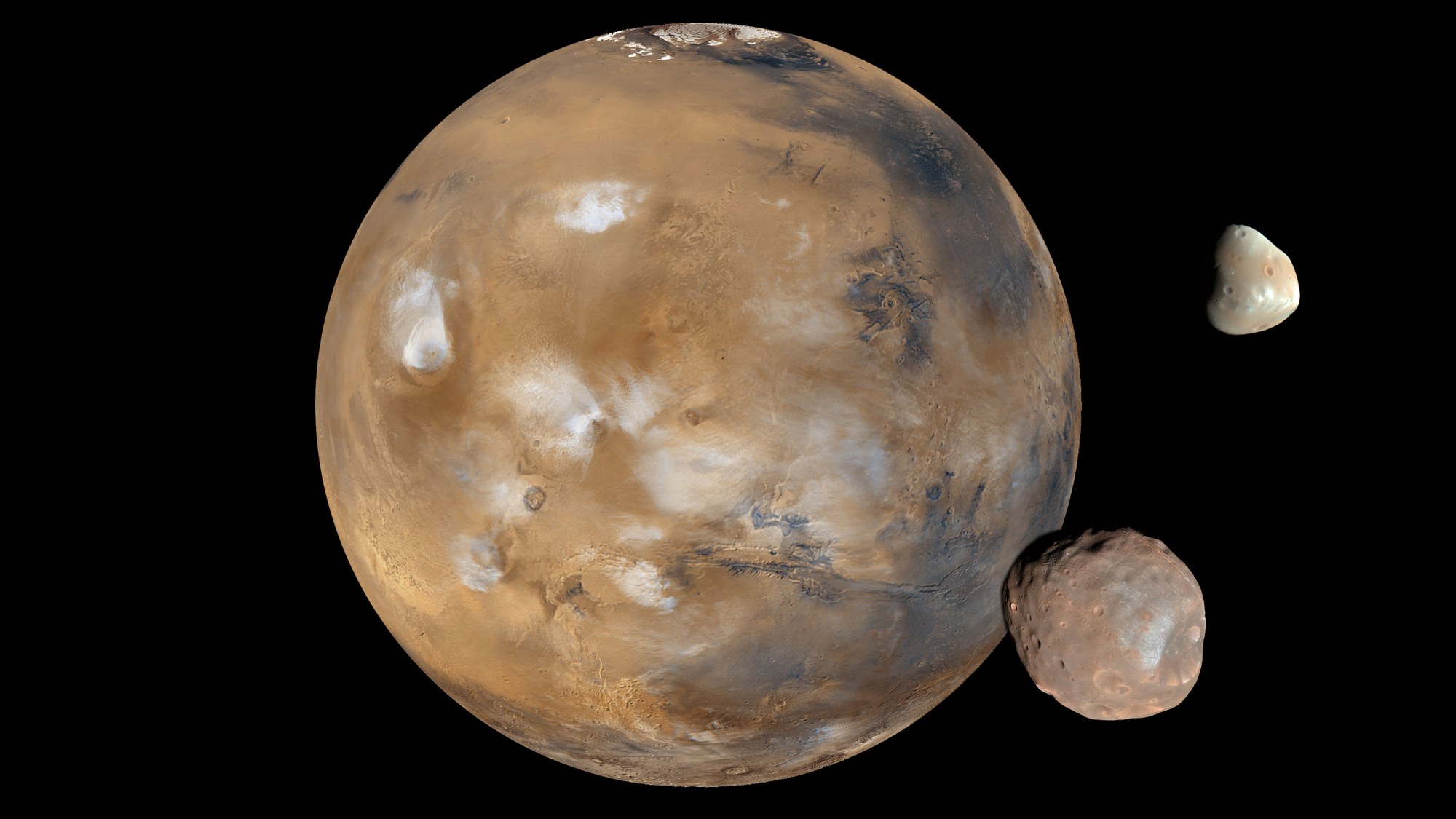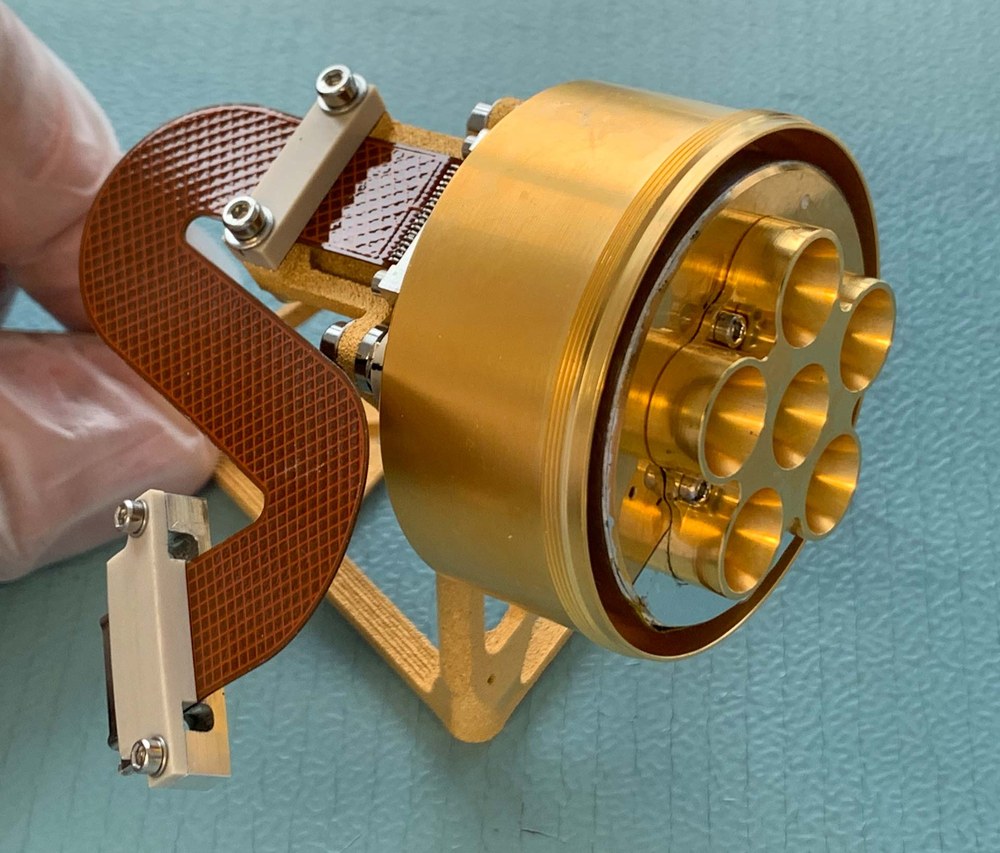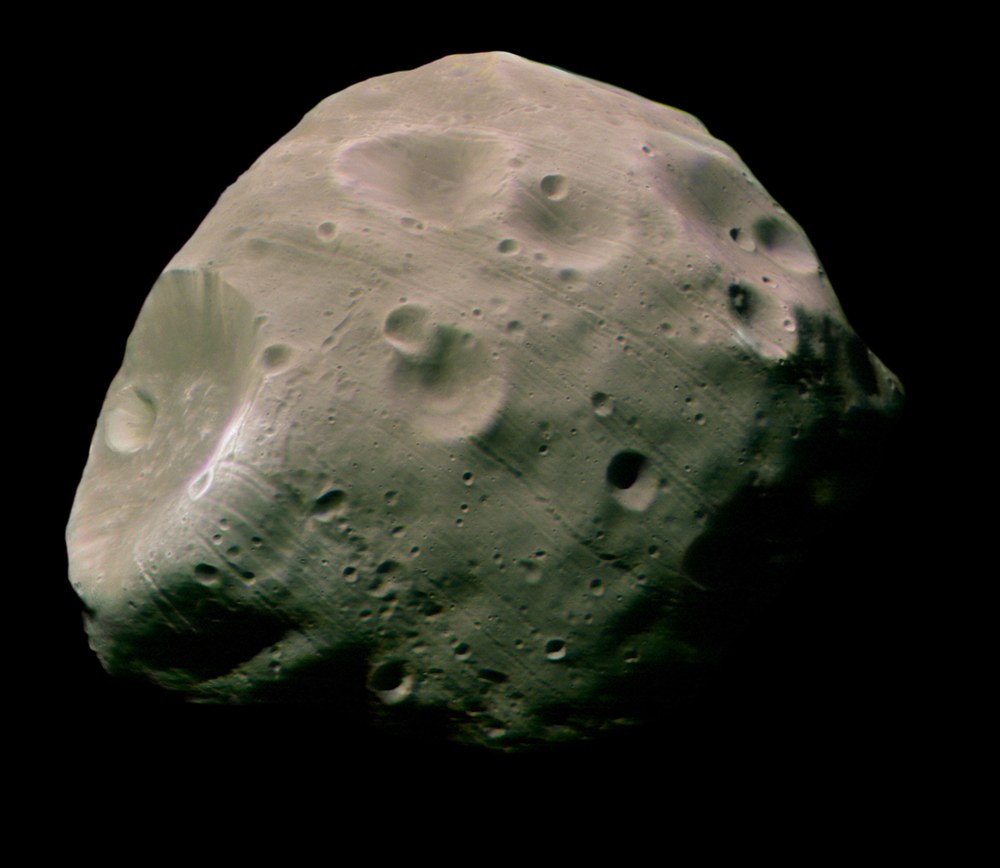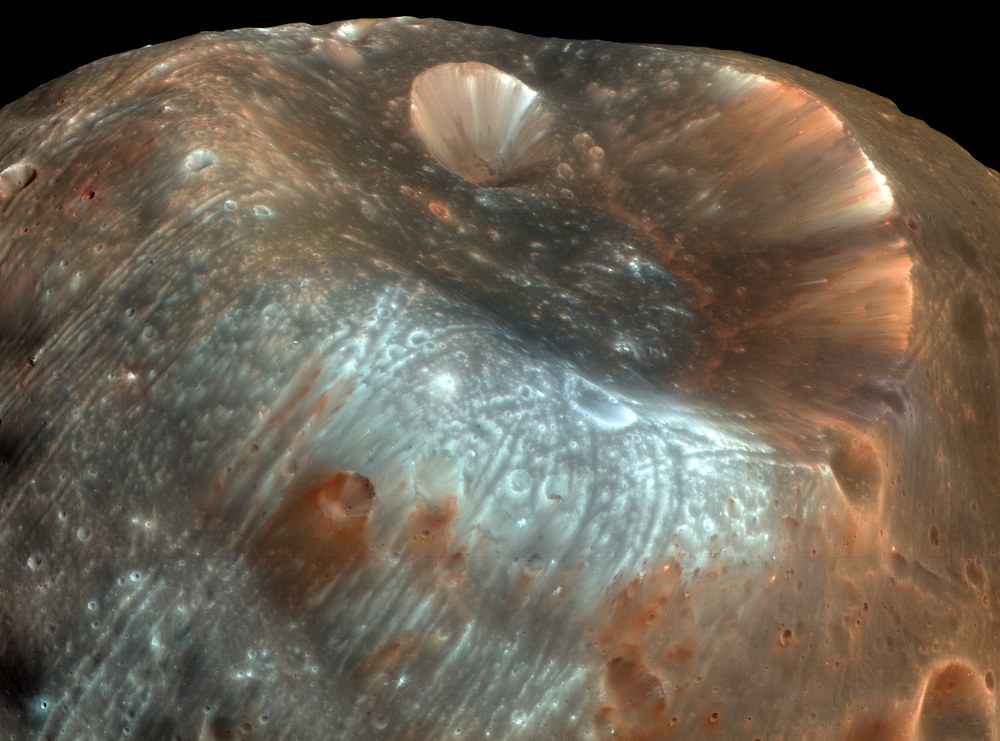On no moon's land

In Roman mythology, Fear and Terror were the frightening companions of Mars, the god of war. This is powerful imagery. In Homer's Iliad, Phobos and Deimos were two brothers who belonged to the entourage of the Greek god of war, Ares. These names were given to the moons of our neighbouring planet when they were discovered by the US-American astronomer Asaph Hall in 1877. Apart from Earth's Moon, they are the only two satellites in the inner Solar System. They are much smaller than the Moon, and due to the low gravitational forces, they are irregular in shape rather than spherical. At its largest, Phobos measures almost 27 kilometres across and Deimos just 15 kilometres. They are so small that telescopes on Earth cannot make out any details of them, but both moons have been observed from up close by Mars probes. This leaves one big question: Where did these diminutive moons come from? Their spectral properties are similar to those of asteroids and hardly like those of Mars. A very special mission could provide the answer – Martian Moons eXploration mission, or MMX.
The history of the discovery of the moons reads like an astronomical thriller. Asaph Hall, born in 1829, took his first post at the Harvard Observatory, where he earned a meagre three dollars a week. He later picked up some more work at the US Naval Observatory in Washington DC. As far as Hall was concerned, the textbooks were correct in stating that Mars had no moons. However, he became sceptical when his mass calculations for Mars, derived from the orbital disturbances of Earth and Jupiter, did not make sense. He began to doubt Mars' moonless status and planned some observations for August 1877, when the Red Planet would be at opposition just 56 million kilometres from Earth.
Persistence pays off
Hall was worried that his colleague and rival, Henry D Holden, would use the large refractor, the Great Equatorial Telescope, on the best nights for observation during autumn 1877, but fortunately his fears proved unfounded. There came a point when Hall was tempted to abandon his search due to poor atmospheric conditions, but his wife Angeline encouraged him to keep looking. And it paid off! On the night of 12 August 1877, Hall noted a faint 'star' near Mars, before it clouded over again. On 16 August he spotted the point of light again, travelling with Mars. He had discovered Deimos. Two days later, he found Phobos. Simon Newcomb, the director of the observatory, brazenly claimed the discovery as his own in the New York Times of 20 August. Henry Holden even claimed to have discovered three more moons orbiting Mars – an early case of fake news, perhaps? Hall did the mathematical calculations and found that these new moons violated Kepler's orbital laws and were repeated observations of Phobos and Deimos. Ultimately, Hall emerged with an impeccable reputation in professional circles for the accuracy of his calculations.
Moons for a limited time only
Phobos orbits Mars in just over 7.5 hours, about 6000 kilometres above its surface. This means that the satellite is rotating faster than the planet, which takes 24.5 hours. In other words, a potential Martian would see Phobos rise in the west and set in the east. No other moons in the Solar System orbit their planet from such a close range. Deimos orbits Mars at an altitude of 23,500 kilometres and has an orbital period of 30 hours.
Measurements by spacecraft and repeated observations by DLR's High Resolution Stereo Camera (HRSC) on the European Space Agency (ESA) Mars Express orbiter have shown that Mars is exerting tidal forces on the two small celestial bodies, altering their orbits. Deimos is moving away from Mars and is likely to be lost to the planet in the distant future – a fate it shares with Earth's Moon. Meanwhile, Phobos is gradually spiralling in towards Mars and is likely to break up when it reaches a proximity of 5500 kilometres – known as the Roche limit – as the tidal forces will be greater than the moon's force of internal cohesion. This is expected to happen in about 40 million years. When this occurs, the rock debris will give Mars a temporary ring.
NASA's Mariner 9 probe sent the first close-up images of the moons back to Earth in 1972. The two US Viking orbiters followed from 1976 to 1980. Then came photos and measurements from NASA's Mars Global Surveyor, Mars Reconnaissance Orbiter, 2001 Mars Odyssey and ESA's Mars Express orbiter. The former USSR and Russia also launched three missions exclusively to study the Martian moons: Phobos 1 and 2 in the late 1980s, which lost radio contact after the transmission of a small amount of data; and the Phobos Grunt mission, which was lost shortly after its launch in 2011. Despite having been photographed, measured and characterised to a limited extent in terms of their geological, mineralogical and geochemical properties, Phobos and Deimos continue to be uncharted territory for planetary research.
Captured or ejected?
Two big questions remain: how did the two moons form, and what are they made of? Both bodies are extremely dark, reflecting only five percent of the sunlight that reaches them – almost like charcoal. Mars, on the other hand, reflects about four times as much on average. Given these facts, it is hard to see how the planet and its moons could share a common origin, but this is still one of the theories. Essentially, there are three theories under discussion: that the moons are asteroids captured by Mars' gravitational field, that they were formed as a result of a massive impact on the planet, or that they formed at the same time as the Red Planet.
The 'capture theory' is supported by the fact that the colour spectrum of both moons resembles that of D-type asteroids: like these celestial bodies, the moons are dark and homogeneously reddish, low in water and rich in carbonaceous and siliceous molecules. Such asteroid moons could have come from beyond the orbit of Neptune. However, this hypothesis is contradicted by the fact that both moons orbit Mars near the ecliptic plane on which all planets and most of their moons move around the Sun. In addition, both orbits are almost circular. Such a coincidence would be difficult to account for under the 'captured asteroids' theory. The orbital parameters lend weight to the third theory, although this is contradicted by the fact that the specific density of the moons, at 1.87 grams per cubic centimetre, is not even half that of Mars.
Recent research suggests that the moons are remnants of a major impact in Mars' early history, which also formed the planet's extensive northern lowlands. The impacting body could have been as large as 2000 kilometres across and knocked out trillions of tonnes of light crust and dark mantle from the young planet. The debris would have formed a ring around Mars, 'giving birth' to Phobos and Deimos, and perhaps even more moons that were either lost or re-impacted on Mars. This theory explains the relatively low and barely elliptical orbits quite well.
Investigating on site takes the cake
Only a spacecraft can help to clarify the origin of Phobos and Deimos, and help us understand the role of small celestial bodies in the development of the planets. This is the purpose of the MMX mission by the Japanese Aerospace Exploration Agency (JAXA). It will be the third JAXA mission to collect samples and bring them to Earth, following the two Hayabusa missions to the asteroid belt. NASA, ESA, the French space agency CNES and DLR are also involved in the mission.
We can look forward to exciting events from 2025 onwards, when the spacecraft observes Phobos and Deimos from orbit. Scientists are currently searching for a suitable landing site for the mothercraft and the small MMX rover. The rover is being developed jointly by CNES and DLR. The Institute of Robotics and Mechatronics in Oberpfaffenhofen is leading the project on behalf of DLR. The vehicle, weighing 25 kilograms, will be dropped gently onto the surface of Phobos from a height of around 50 metres. On Phobos, the gravitational pull is one two-thousandth of that on Earth, so the rover will come to rest after bouncing several times. It will then autonomously manoeuvre itself into an upright, ready-to-launch position. The rover will move around Phobos and explore it with instruments including a radiometer and a Raman spectrometer, in the development of which DLR is playing a major role. A little later, it will take samples that are scheduled to reach Earth in 2029. Regardless of how Phobos and Deimos formed, it is likely that later impacts from Mars also ejected material at Phobos. In any case, the samples from this moon will also contain traces of the planet, which will make MMX the first mission to bring Mars samples to Earth.
Phobos' most striking surface structure is a nine-kilometre-wide impact crater that almost destroyed the moon when it formed. It was first photographed by Mariner 9 in 1972 and given the name Stickney by the Naming Committee of the International Astronomical Union as a tribute to Asaph Hall's resolute wife, Chloe Angeline Stickney Hall, who persuaded her husband to continue with his work. Stickney was her maiden name. In 1878, Asaph Hall wrote, "I would have given up searching for the moons of Mars had my wife not encouraged me to keep looking." What a story!
MMX – Martian Moons eXploration
MMX is a mission by the Japanese space agency JAXA with contributions from NASA, ESA, CNES and DLR. Scheduled for launch in September 2024, and an expected arrival at Mars in August 2025, it aims to characterise the Martian moons Phobos and Deimos and clarify how and where the two satellites formed. MMX consists of the following:
- Exploration module with landing legs and sampler with eight instruments
- Rover
- Return module with sample recovery capsule and three instruments
- Propulsion module with fuel tanks and thrusters for Mars orbit insertion
The rover was developed in a joint project by CNES and DLR. It weighs almost 25 kilograms, including four kilograms of components on the mother craft. For DLR, the institutes of Space Systems, of Lightweight Systems, of System Dynamics and Control, of Optical Sensor Systems, of Planetary Research and the Microgravity User Support Center (MUSC) are also involved under the leadership of the DLR Institute of Robotics and Mechatronics.
The goal is to study the geological, physical and mineralogical properties of Phobos' surface and demonstrate low-gravity mobility. The data will also be used to calibrate the orbiter measurements and will support the landing of the exploration module. Data exchange with Earth will take place via the orbiter. The rover's operations will be controlled from the control centres of CNES in Toulouse and at DLR's Microgravity User Support Center (MUSC) in Cologne. It has:
- Stereo camera (NavCAM)
- Wheel cameras on the chassis (WheelCAM)
- Radiometer (minRAD)
- Raman spectrometer (RAX)
Instruments with DLR participation on the MMX rover

The miniRAD radiometer from the DLR Institute of Planetary Research will measure surface radiation at six thermal infrared wavelengths. This gauges the surface temperature, which depends heavily on the thermal properties of the surface materials, in addition to the irradiation conditions. Measuring the radiation makes it possible to draw conclusions about the material properties. The thermal properties also give an indication of the porosity, enabling direct comparison between measurements for asteroids and comets, as well as asteroid and meteorite samples.

The Raman spectrometer RAX (RAman spectroscopy for MMX) was developed by the DLR Institute of Optical Sensor Systems, JAXA (under the leadership of the University of Tokyo), and Spain's National Institute of Aerospace Technology (INTA). RAX will characterise the mineralogical composition along the rover's path to help us understand the processes that Phobos could have undergone. The Raman measurements on Phobos will be compared with measurements taken by other rovers on Mars to evaluate the different formation hypotheses. Comparison with the measurements from the samples returned to Earth by MMX will show how representative the samples are.
An article by Ulrich Köhler from the DLRmagazine 171



